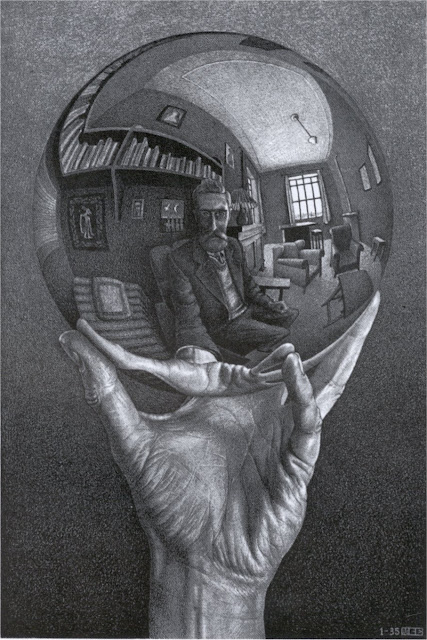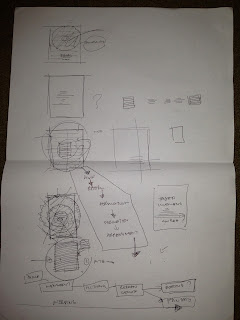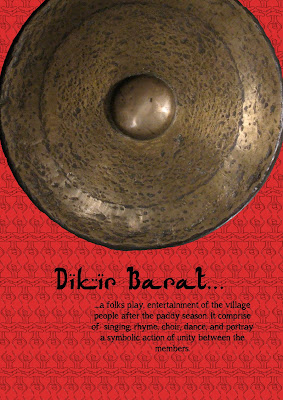Media Art Design 2
Assignment 01#
This actually an individual project.We are required to create two conceptional screen
based works :
1) Art (personal)
2) Design (to create inquiry)
First,we were asked to create a group of two people to make a research on media artist and traditional dance. My part is on the Media Artist.
Here's my partner's research on Traditional Dance at his blog :
mediaartsdesign0102.blogspot.com
(Stage 1) :Brainstorming
Mindmap of Media Artist :
This actually an individual project.We are required to create two conceptional screen
based works :
1) Art (personal)
2) Design (to create inquiry)
First,we were asked to create a group of two people to make a research on media artist and traditional dance. My part is on the Media Artist.
Here's my partner's research on Traditional Dance at his blog :
mediaartsdesign0102.blogspot.com
(Stage 1) :Brainstorming
Mindmap of Media Artist :
Mindmap of Traditional dance :
(Stage 2) :Research & Facts Finding
Media Artist : M.C. Escher
Media Artist : M.C. Escher
After I've done several research on media artist online ,me and my partner has decided to choose M.C. Escher as our media artist.So,now is my job to do a research on him.
M.C. Escher
Biography
Maurits Cornelis Escher was born in Leeuwarden (in the Netherlands) in 1898, the son of an engineer, G.A. Escher. The family moved to Arnhem in 1903, where he entered high-school at 13 (until then he took carpentry and piano lessons). He wasn't a good student, although his art teacher noticed his talent - twice he had to repeat a grade and he failed to obtain a diploma on leaving.
In 1919, following the wish of his father, he went to Haarlem to study at the School of Architecture and Decorative Arts in Haarlem under the architect Vorrink. But after assisting to a lecture of Samuel Jesserun de Mesquita on graphic techniques, Escher realised that his talents lay more in the direction of the decorative arts than in that of architecture. He then changed courses and de Mesquita became his main teacher. Work from this period show that he was mastering the technique of woodcut.
Escher left the art school in 1922, after he acquired a good grounding in drawing and he had so mastered the art of the woodcut that de Mesquita thought he was ready to go his own way. He kept regular contact with de Mesquita and he would send the master copies of his latest pieces of work.
In 1919, following the wish of his father, he went to Haarlem to study at the School of Architecture and Decorative Arts in Haarlem under the architect Vorrink. But after assisting to a lecture of Samuel Jesserun de Mesquita on graphic techniques, Escher realised that his talents lay more in the direction of the decorative arts than in that of architecture. He then changed courses and de Mesquita became his main teacher. Work from this period show that he was mastering the technique of woodcut.
Escher left the art school in 1922, after he acquired a good grounding in drawing and he had so mastered the art of the woodcut that de Mesquita thought he was ready to go his own way. He kept regular contact with de Mesquita and he would send the master copies of his latest pieces of work.
Italy
After leaving school, Escher spent time traveling through Italy, and in the autumn he would return there. He spent the winter of 1922 and the spring of 1923 in Siena, where he produced the first woodcuts of Italian landscapes. He also met here his future wife, Jetta Umiker, whom he was to marry in 1924. After the wedding the couple moved to Rome, where their first son, George, was born in 1926.
Until 1935, Escher, together with other fellow artists, would set-off each spring on a two-month journey in the Abruzzi mountains, Campania, Sicily, Corsica and Malta, from where he would collect impressions and make sketches. During this period, he was not very well known. He had held a few exhibitions and illustrated some books. He hardly sold any work, and he remained dependent on his parents.
Until 1935, Escher, together with other fellow artists, would set-off each spring on a two-month journey in the Abruzzi mountains, Campania, Sicily, Corsica and Malta, from where he would collect impressions and make sketches. During this period, he was not very well known. He had held a few exhibitions and illustrated some books. He hardly sold any work, and he remained dependent on his parents.
Switzerland, Belgium, The Netherlands
In 1935, the political climate in Italy became unacceptable to Escher, so the family left Italy and settled in Switzerland, at Chateau d'Oex. They stay here was, however, very short, due to the harsh climate and the landscape, which afforded him no inspiration. He then decided to travel in the Mediterranean region on a cargo vessel, in exchange for some of his paintings. The journeying, partly comprising travels in the south of Spain, had a great impact on Escher's work. For example, visiting the Alhambra in Granada, where he studied the Moorish ornamentations, inspired him to work on tessellations of the plane.
In 1937 he moved to Ukkel, near Brussels, Belgium, and because of the war, he settled in 1941 in Baarn, Holland. It was here where the richest work of the artist quietly flourished. His recognition and success came after 1955. After 1953, he became a lecturer at many organisations and he wrote a book with illustrations and text for some lectures, which was later published as part of the book Escher on Escher. In July 1969, he finished his last work before his death. In 1970 he moved to Laren, in North Holland, where he died in 1972.
In 1937 he moved to Ukkel, near Brussels, Belgium, and because of the war, he settled in 1941 in Baarn, Holland. It was here where the richest work of the artist quietly flourished. His recognition and success came after 1955. After 1953, he became a lecturer at many organisations and he wrote a book with illustrations and text for some lectures, which was later published as part of the book Escher on Escher. In July 1969, he finished his last work before his death. In 1970 he moved to Laren, in North Holland, where he died in 1972.
Selected Works
The Tower of Babel
The Waterfall

Stairs
Hand with Reflecting Sphere
Print Gallery
Day & Night
Lizards
Formations
Butterflies
Into the Dark
Birds & Fishes
Traditional Dance : Dikir Barat
Explanation of what is dikir barat or the the meaning of dikir barat is merely a folks play, entertainment of the village people after the paddy season. It comprise of singing, rhyme, choir, dance, and portray a symbolic action of unity between the members. Here i put dikir barat in my own words from what i had experienced by years of my involvement in dikir barat. My explanation is what had i learned from the people who is more experience from me, no books, no in-depth study or special note to be pull out from library, its just long life learning process. Written sources that i had found, books,wiki, or personal blogs sometime does not fulfill the requirement to be taken as the source, I'm not saying mine is solid but what ever i wrote here is well learned and confirmed. Here briefly what is Dikir barat for your understanding:-
Dikir barat is form of play which form of three part, the lead singer known as "Tok Jogho", a second singer known as "Tukang Karut", a group singer called "Awok-awok", and the Musician. This group contains of 15 to 25 personnel where the most is the "awok-awok". the orientation of performance can be a solo group performance or between group performance. If its happen to have more than one group it will be more to competition orientations. However it will depends on the occasion, some performance needs two group for a merrier situation, it's not always about competition when two dikir barat group come together but sometimes its a learning process of new dikir barat group to feel and learn from the more experience group. There is no books and manual, the way you can learn is by visually and verbally attach to the more experienced people. For more experience group they make a duel just to test how far they had improve their skills.
My Ideas, Opinion & Thinking
- Why I choose the artist? Because of the style?
- What about the artist work that you like most and WHY? Justify.
- Justify in many sentences and NOT 1 word.
I choose M.C. Escher as my media artist because for some reason I like his works. Everytime I look at all of his paintings, it will take me at least five minutes to observe the painting from all perspectives. I can say most of his painting are eye-catchy and sometimes mind-twisted. He like to create an impossible construction through his painting that carry out complication on the actual meaning that he want to show to the audience. Another thing that makes me like him are his drawing style.Pencil drawing black and white with the realistic effects totally grab my interest.His style on some of his paintings is using mathematical grid that brings out the neatness and clarity.
(Stage 3) : Precedence Studies
There is similarity of element in dikir barat and M.C. Escher's artwork and masterpieces. The one element that I found in both media artist's artwork and traditional dance is the element of uniformity. Uniformity is described as the state or quality of being uniform, overall sameness.
As you can see the pictures above, both M.C. Escher's artwork and dikir barat is well organized and is in a uniform. They move and work as one. One for all, all for one. A well established artwork and masterpieces will create peace and harmony just by looking at it. It also will attract viewers eye and people will not lose their attention towards it.
(Stage 4) : Project Brief
Purpose of Design : To show the originality of Dikir Barat because it was full of maze and cloud where it is until today debatable, but for sure what i had observe dikir barat in the form of what we here in Peninsular Malaysia, Sabah and Sarawak including Singapura practices is based in kelantan, a state in Malaysia.
Target Audience : My target audience is among teenagers might be around 16 to 25.
Idea Development & Process (Thumbnail&Sketches)
First Design Ideation
Second design Ideation
Final Artwork
1)Design
Media Art Design 2 : Assignment 1
Artwork Title : "Dikir Barat"(Design)
Name : Sharedzuan Samsudeen
ID: 1102702495
Target Audience : My target audience is among teenagers might be around 16 to 25.
Artist Statement : "To show the originality of Dikir Barat because it was full of maze and cloud where it is until today debatable, but for sure what i had observe dikir barat in the form of what we here in Peninsular Malaysia, Sabah and Sarawak including Singapura practices is based in kelantan, a state in Malaysia."
Artist Treatment : Adobe Photoshop CS5
2) Art
Media Art Design 2 : Assignment 1
Artwork Title : "Dikir Barat"(Art)
Name : Sharedzuan Samsudeen
ID: 1102702495
Artist Statement : "I've used the Escher-Tessellation technique in my artwork to bring the element of formation inside dikir barat.It represent the unity among the members."
Artwork Treatment : Adobe Photoshop CS5.
THANK YOU! =)











































